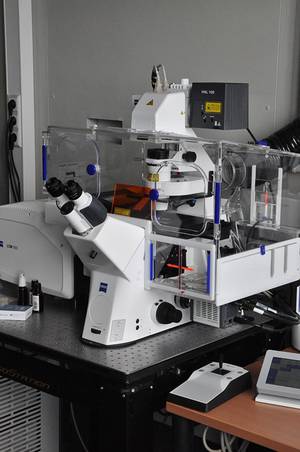Super-resolution microscopy
Compared to eukaryotic cells bacteria are tiny. Nonetheless the emerging field of bacterial cell biology has revealed an unimagined degree of structural organisation within bacterial cells. In order to study, for instance, the composition and interaction of large biosynthetic machineries, the localisation of individual proteins, their movements and fluctuations, a resolution below the optical diffraction limit is instrumental.
Zeiss LSM 800 confocal microscope with AiryScan
Key features:
- AiryScan detector (1.7 times higher resolution and higher sensitivity than standard confocal systems)
- compatible with common life-cell fluorescent dyes like GFP, mCherry etc.
- wide field-setup (fluorescence and phase contrast)
- Plan apochromat objectives (e.g. 63x, 100x / NA 1.46)
- climate chamber for life-cell imaging (temperature, gas, and humidity)
- Definite Focus for automated focus stabilisation
- light sources: Colibri and a HXP arc lamp
- camera Hamamadzu Orca Flash 4.0 V
- suitable for FRAP (fluorescence recovery after photobleaching) studies
Research examples
Localisation and progression of FtsZ ring assembly in Bacillus subtilis
Christian Mayer, Heike Brötz-Oesterhelt and Peter Sass
Department of Microbial Bioactive Compounds
In B. subtilis, bacterial cell division is initiated by the FtsZ protein, which forms a ring-like structure, the so-called FtsZ-ring (or Z-ring), at the prospective division site. Super-resolution microscopy allows for resolving and following the individual steps of Z-ring assembly and constriction. The consecutive steps are numbered in the image. (1) The function of FtsZ relies on its GTPase activity, which promotes FtsZ assembly into helical bundles of FtsZ protofilaments that may occur throughout the cell. (2) After the cell cycle has sufficiently proceeded (e.g. segregation of the nucleoids), the FtsZ protofilaments condense into the Z-ring structure at mid-cell which is the prerequisite for the recruitment of further proteins necessary for septum formation (e.g. transglycosylases/ -peptidases). (3-4) Later, the Z-ring constricts (followed by the cell wall biosynthesis machinery) until it eventually closes and septum formation is finalized.
Monitoring cell-cell communication in cyanobacteria by FRAP
Jan Bornikoel & Iris Maldener
Department of Organismic Interactions
FRAP studies allow the analysis of intercellular communication in Anabaena cells. Upon loading filaments with a specific dye, selective cells can be bleached with a laser and the recovery of the fluorescent signal in the bleached cell can be monitored. The fluorescent tracer diffuses over direct cell-cell joining structures from one cytoplasm to the neighbouring cytoplasm. Measurements of recovery rates in mutants help to identify molecular components of these cell-cell joining structures.

